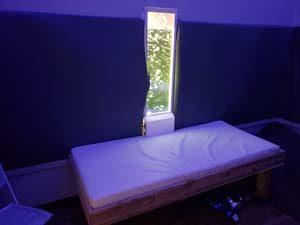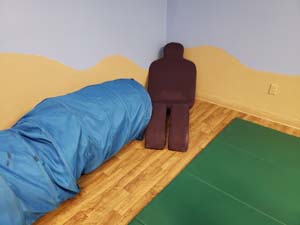Whether it’s a computer for a secretary or a hammer for a carpenter, we all have tools that we require in order to do our jobs effectively.
 Relaxing sensory room
Relaxing sensory room
If someone becomes agitated, they have a relaxing environment with low lights, soft seating, and calming displays at their disposal. A fibre optic curtain adds a tactile component as the tubes can be held while clients observe the changing colours, and a Bluetooth speaker is available to fill the room with calming music.
“Just like you and I – the sensory space allows them to relax, and before you know it, they’re back into the zone,” Michelle said.
If they need to be brought up from a low state, a bright room with an image of a summer sky on the roof has a ball pit, a swing, and a trampoline, amongst other activities, available to assist. The walls in this room are sand-coloured and textured, again providing tactile stimulation.
In both cases, staff monitor clients’ responses to the sensory equipment and are aware of the individual effects caused. Once they return to their baseline – the optimal level of sensory functioning – they are able to resume their daily tasks.


